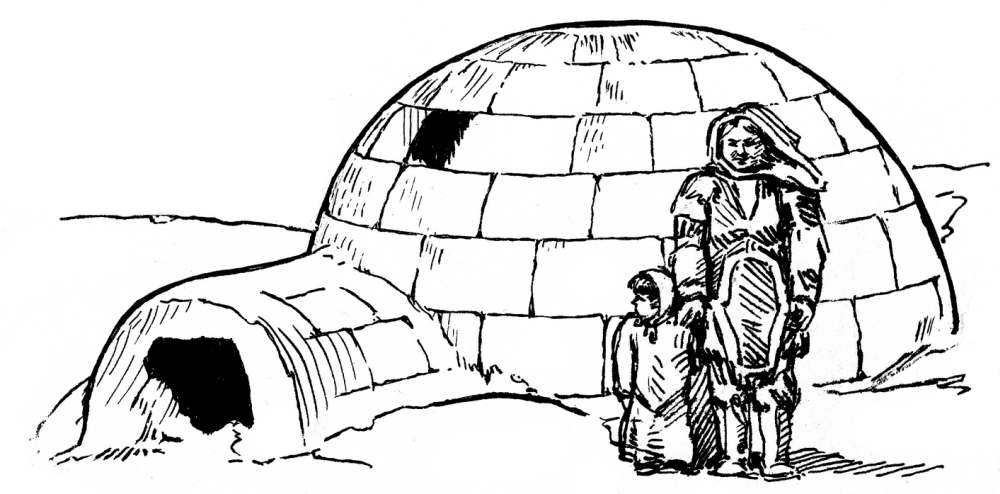Igloos, the iconic snow houses traditionally associated with the Inuit peoples of the Arctic, have long fascinated those from warmer climes with their ingenious design and survival utility. Far from being mere shelters, igloos are masterpieces of indigenous engineering, tailored to withstand some of the planet’s most extreme conditions.
Despite their simple materials and construction, igloos offer a warm, stable environment that has enabled Arctic peoples to thrive in harmony with their harsh surroundings for centuries. This article will unveil some of the most intriguing facts about igloos, from their construction and thermal properties to their cultural significance, offering a glimpse into the remarkable adaptability and ingenuity of human habitation.
What is an Igloo?
An igloo, derived from the Inuit word “iglu,” meaning “house,” is a temporary shelter constructed from blocks of snow, carefully cut and arranged in a spiral pattern to form a dome. Traditionally used by the Inuit people of Canada’s Arctic regions, as well as by other cultures living in similar environments, igloos are specifically designed to utilize the insulating properties of snow, keeping the interior surprisingly warm despite freezing outdoor temperatures. The classic igloo features a small entrance tunnel, which helps to retain heat inside, and a ventilation hole at the top to ensure fresh air circulation and prevent the buildup of moisture.
Contrary to popular belief, igloos are not uniform in size or shape but can vary significantly based on their intended use. Some are built as temporary overnight shelters for hunters or travelers, while others are constructed as part of larger winter villages, complete with multiple rooms and communal areas. The art of igloo building is passed down through generations, requiring skill and knowledge of snow conditions to create a sturdy, warm shelter.
The Temperature Inside an Igloo
One of the most fascinating aspects of igloos is the temperature difference between the inside and the outside environment. Despite the freezing temperatures that can plummet well below zero in the Arctic regions, the interior of an igloo remains comparatively warm and habitable. This remarkable insulation is primarily due to the snow used to construct the igloo, which traps air in its structure, acting as an insulating barrier against the cold.
Inside an igloo, temperatures can rise significantly above the outside air temperature, thanks to the body heat of the occupants and any additional heat sources, such as oil lamps or small fires. It is not uncommon for the interior to be cozy enough for inhabitants to comfortably remove their outer layers of clothing. Temperatures inside an igloo can range from just below freezing to as high as 16 degrees Celsius (60 degrees Fahrenheit), depending on the number of occupants and the heat they generate.
Materials Used to Make an Igloo
The primary material used to construct an igloo is snow, but not just any snow—the type and quality of snow are crucial for building a sturdy and insulating igloo. The ideal snow for igloo construction is compact and cohesive, with a consistency that allows it to be easily cut and shaped into large, sturdy blocks. This type of snow is often found a few days after a snowfall once it has settled and partially fused together under its own weight, creating a workable texture that’s neither too powdery nor too icy.
Builders use a snow knife or a saw to cut the blocks, which are then carefully arranged in a spiral pattern to form the igloo’s dome shape. The blocks naturally lean inward as they are stacked, creating a self-supporting structure that is remarkably stable once completed. The ingenuity of igloo construction lies in the understanding and utilization of snow’s insulating properties, turning a seemingly cold material into a warm and protective shelter.
In addition to snow blocks, soft snow is used to fill any gaps between the blocks, further insulating the igloo and preventing wind from penetrating its walls. The entrance tunnel, often constructed from smaller snow blocks or simply carved out of the snow, also plays a vital role in retaining warmth inside the igloo.
Other Interesting Facts About Igloos
Igloos are more than just snow shelters; they embody a rich history and showcase the ingenuity of Arctic peoples. Here are some interesting facts about igloos that highlight their uniqueness:
- Natural Refrigeration: Despite being warm enough inside to take off outer layers, igloos can also keep cold air in, acting like a refrigerator for storing food during hunting trips in the freezing Arctic environment.
- Acoustic Properties: The snow walls of an igloo can muffle sounds from the outside, creating a surprisingly quiet interior. This feature is particularly useful in the loud, windy Arctic landscape.
- No Foundation Required: Unlike most structures, igloos do not require a foundation. They are built directly on the snow or ice, making them ideal for the transient needs of hunters and travelers.
- Temporary but Sturdy: While igloos are generally considered temporary shelters, they can last for weeks or even months in consistently cold conditions, offering durable protection against the elements.
- Cultural Symbol: Beyond their practical use, igloos have become a cultural symbol of the Arctic peoples’ resilience and adaptability, representing a deep connection to and understanding of their environment.
- Varied Sizes: Igloos can range from small shelters for one or two people to larger communal structures, known as “qaggiq,” used for gatherings, ceremonies, or as temporary villages during hunting seasons.
These facets of igloos reveal the depth of knowledge and skill involved in their construction and use, illustrating why they remain one of the most fascinating and iconic types of shelter in the world.
Conclusion
Beyond their structural and practical benefits, igloos hold a significant place in the cultural heritage of these communities, symbolizing resilience, cooperation, and a profound connection to the land. The fascinating aspects of igloos, from their acoustic properties to their role as natural refrigerators, underscore the ingenuity embedded in traditional practices.


